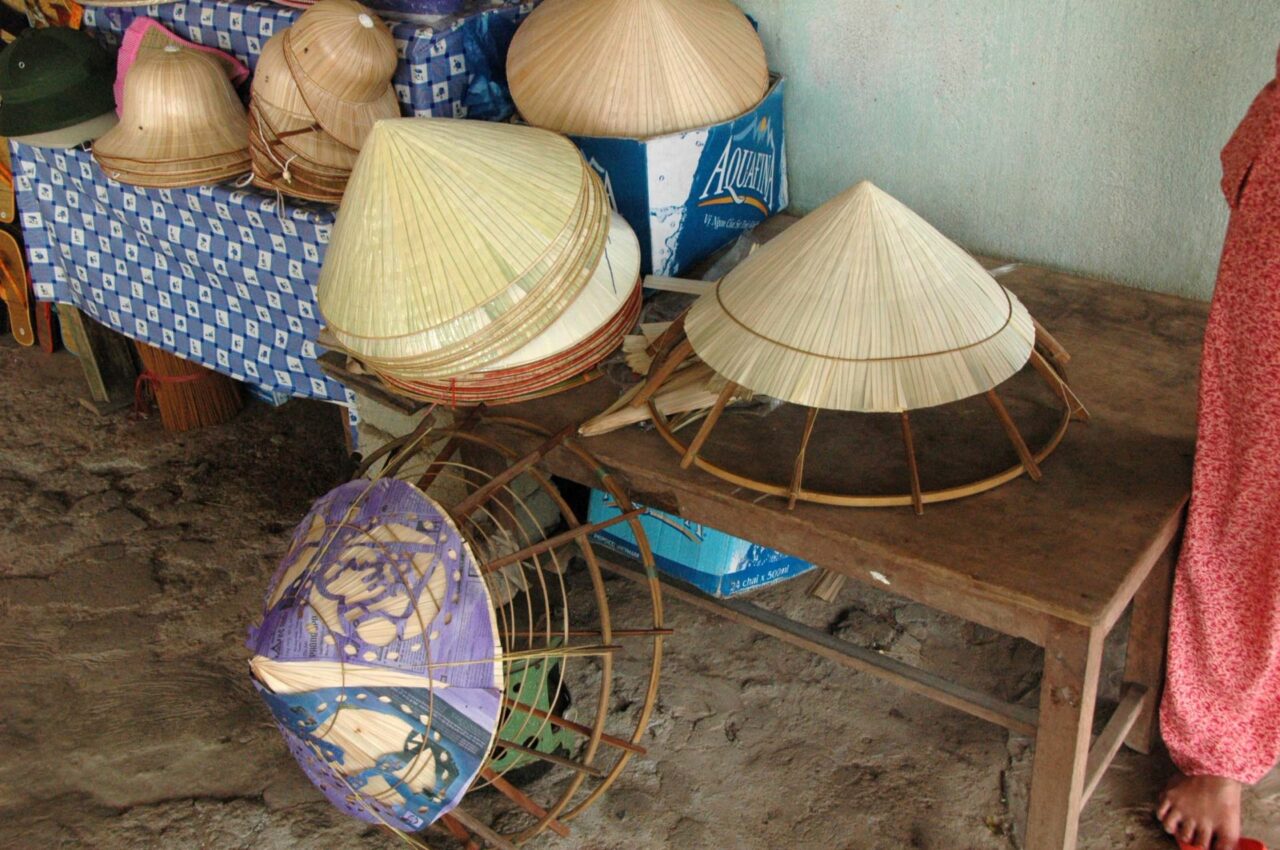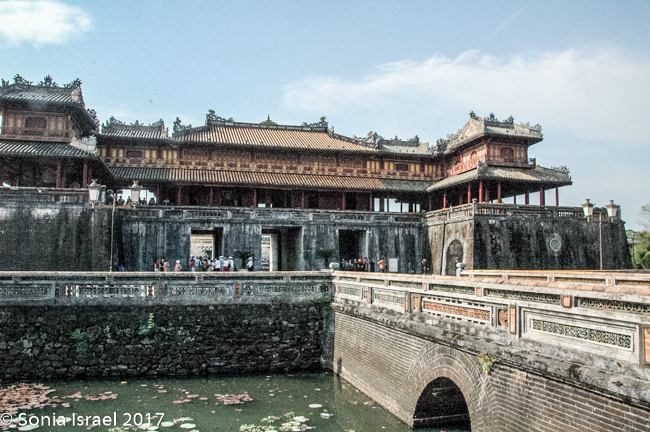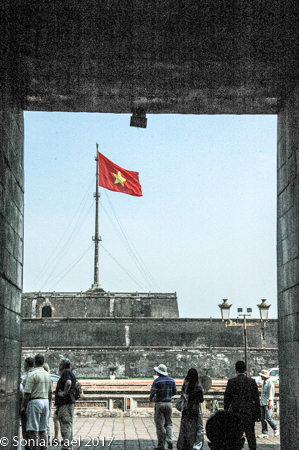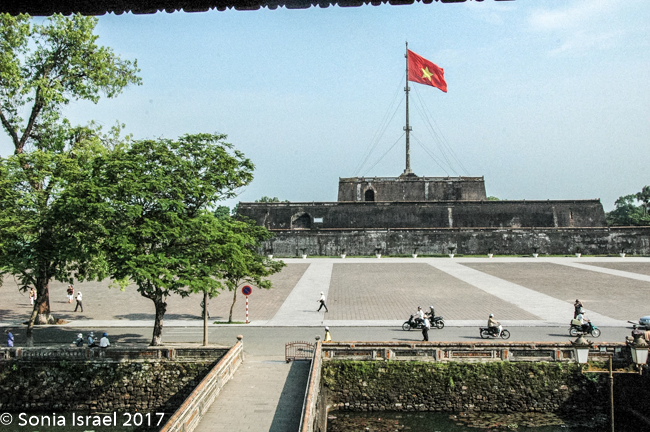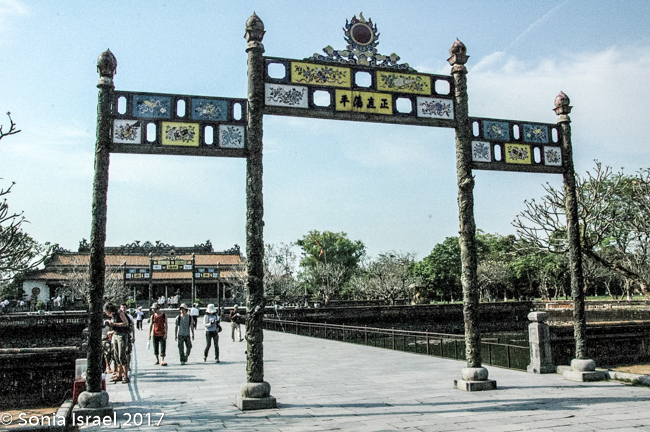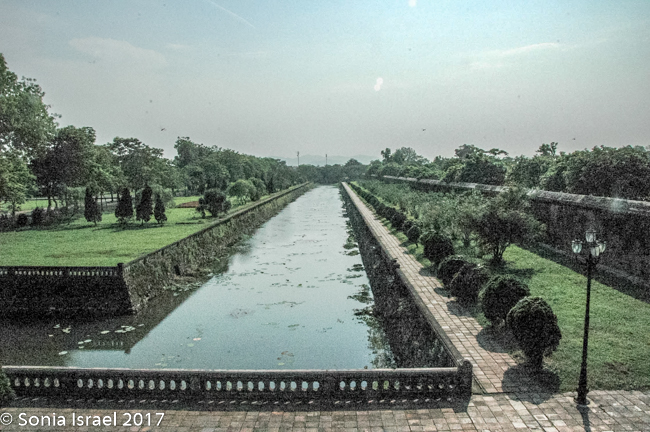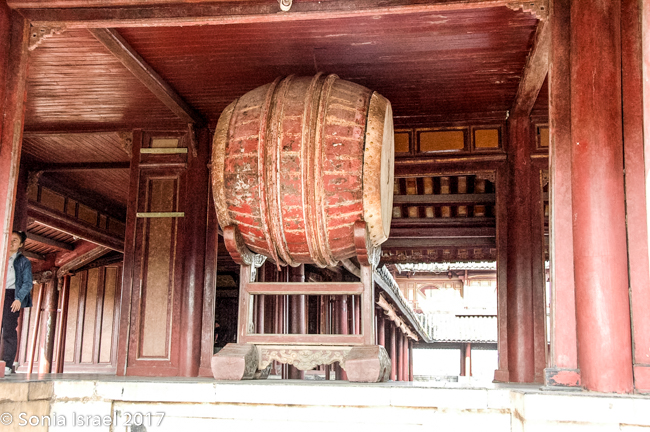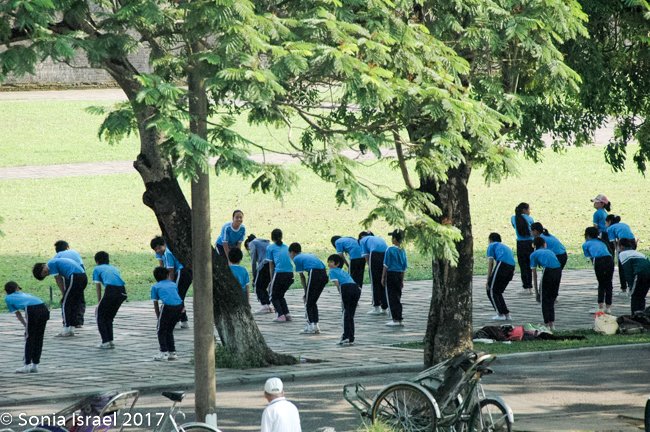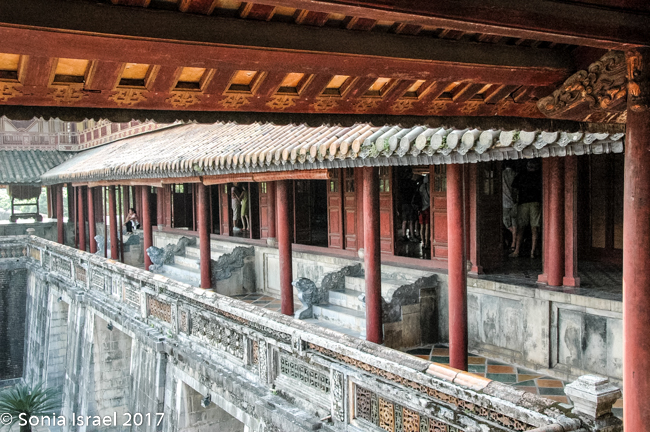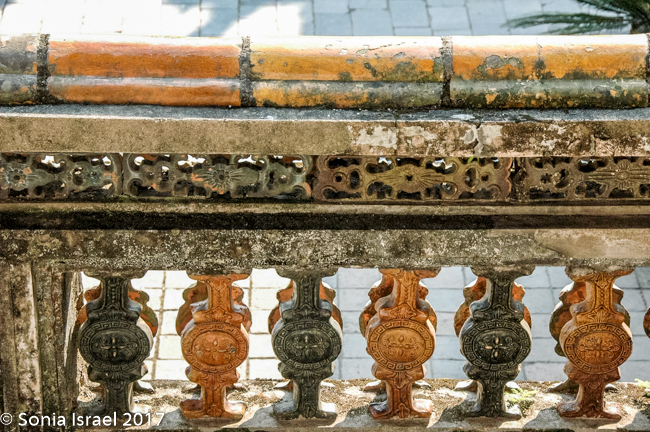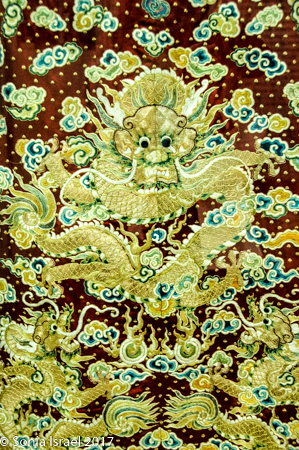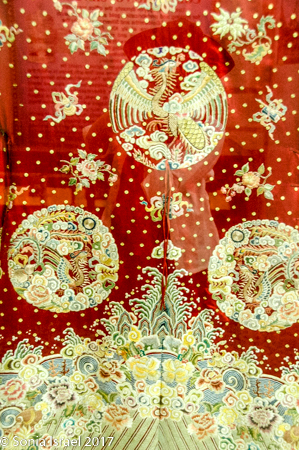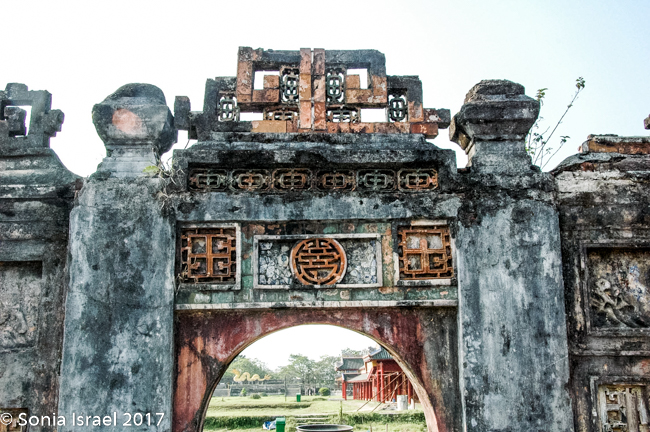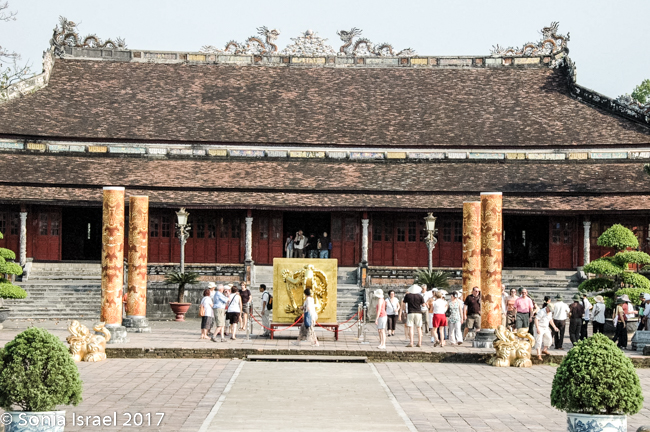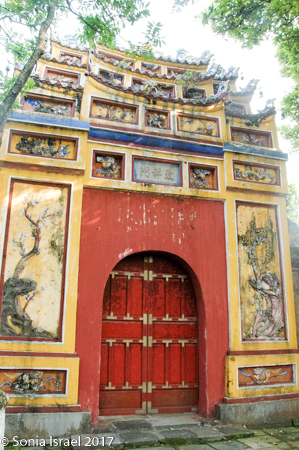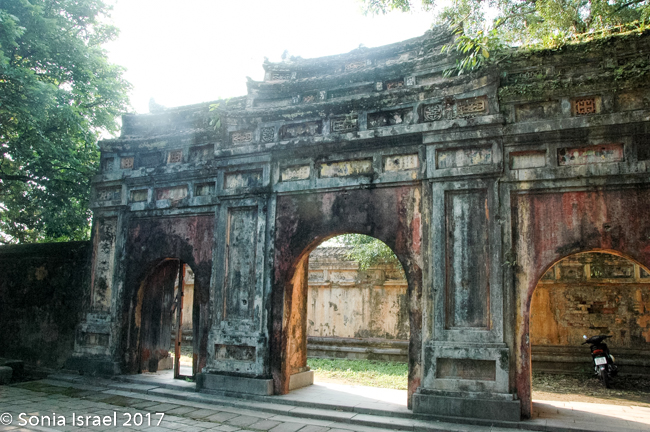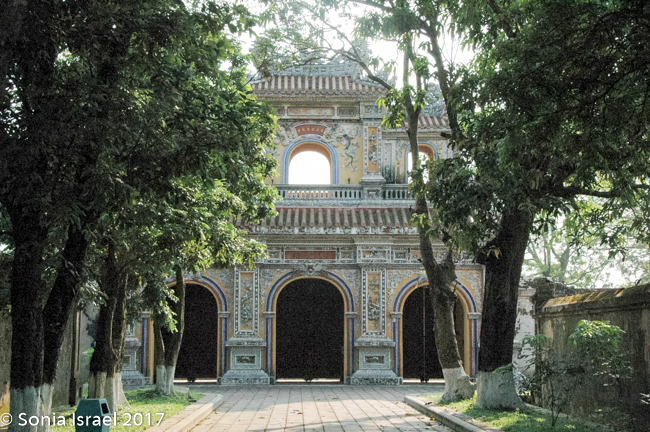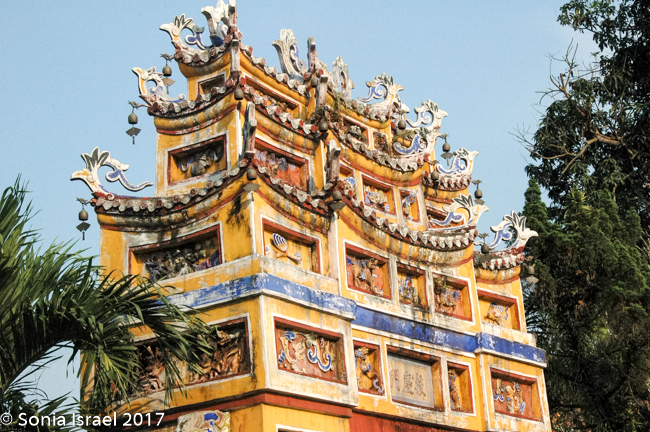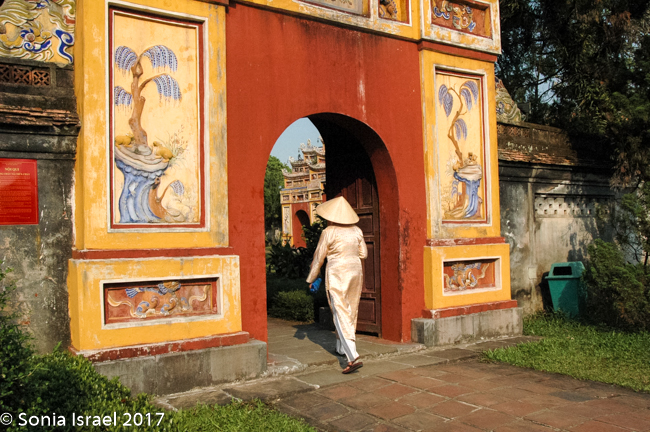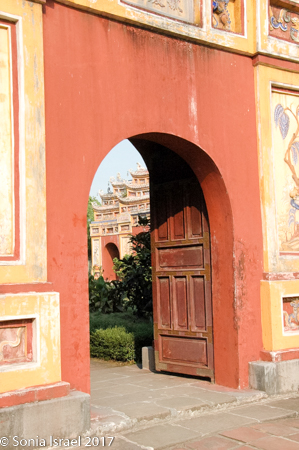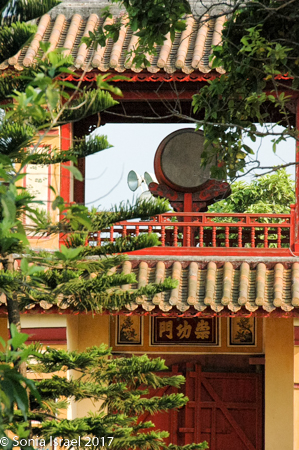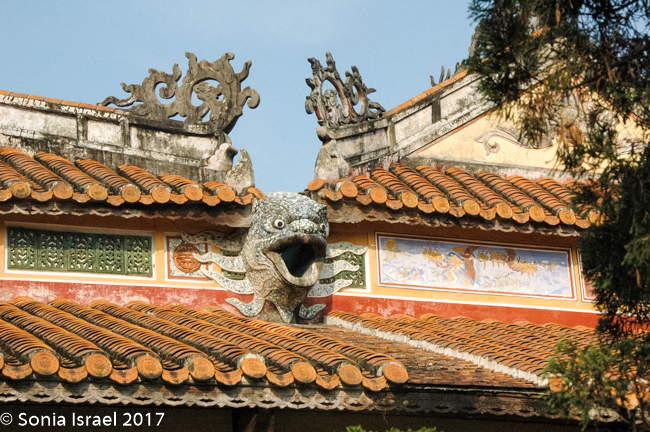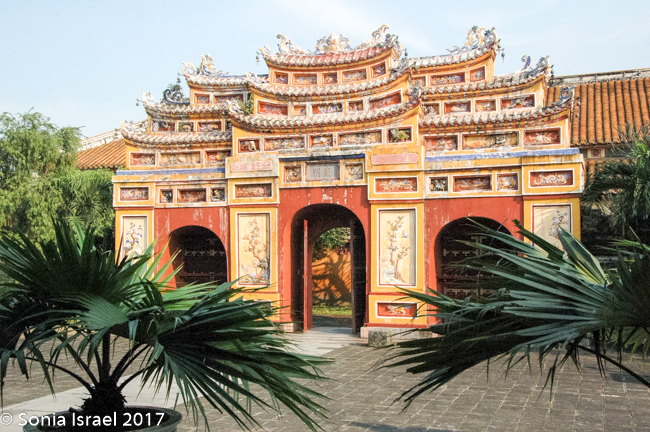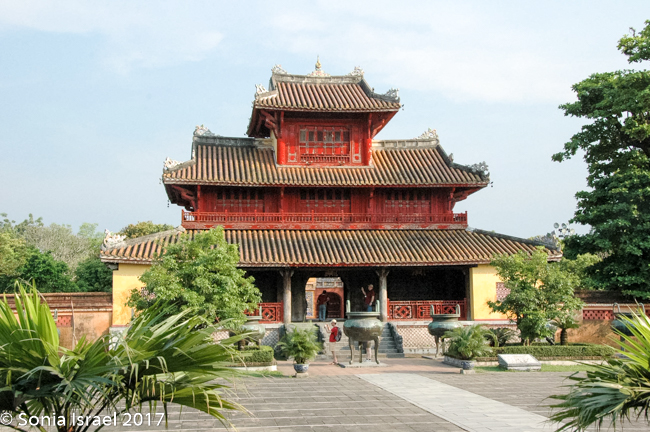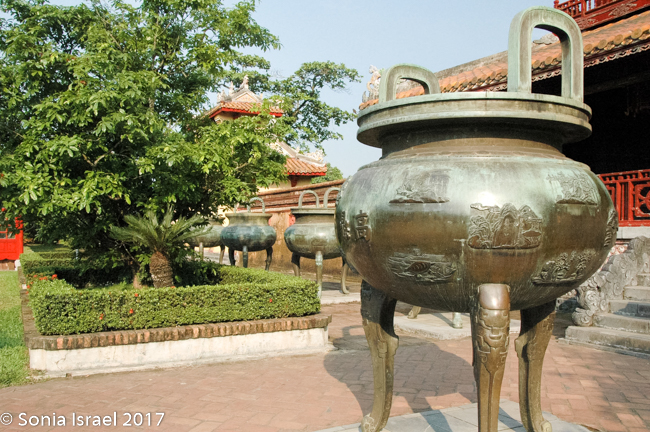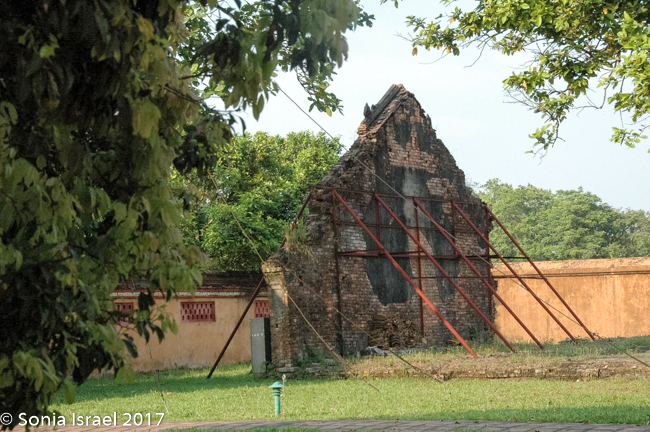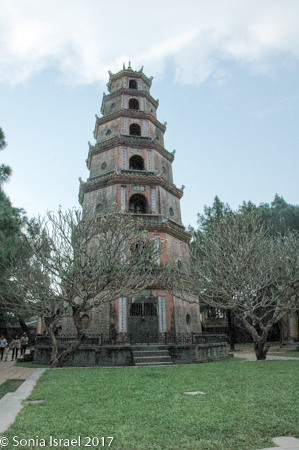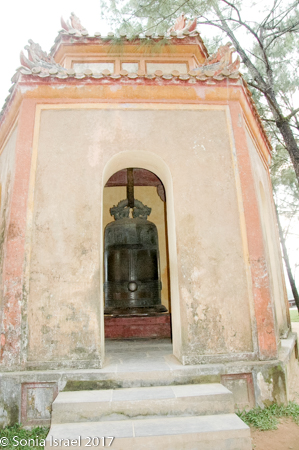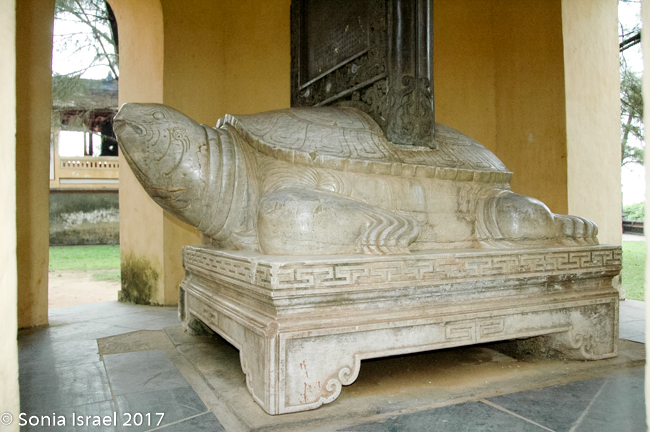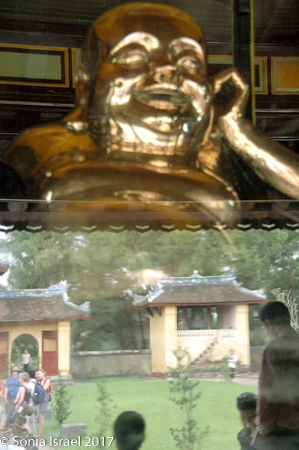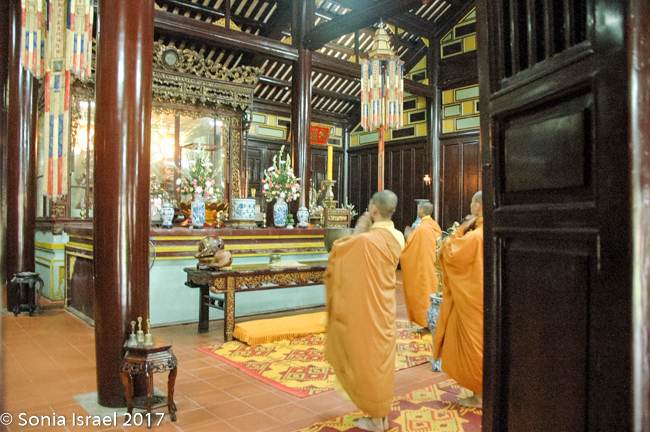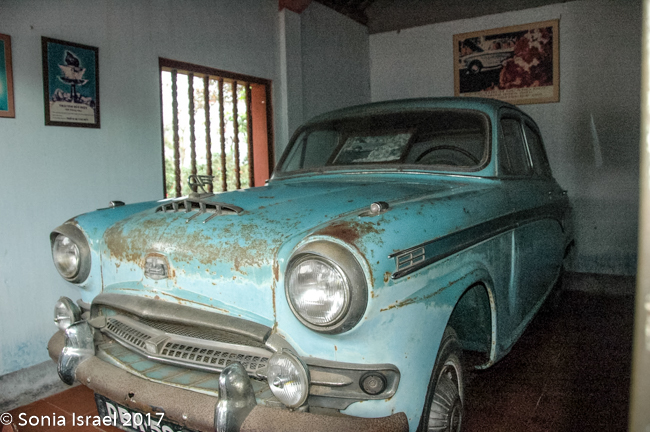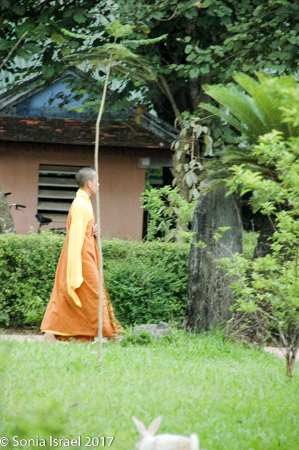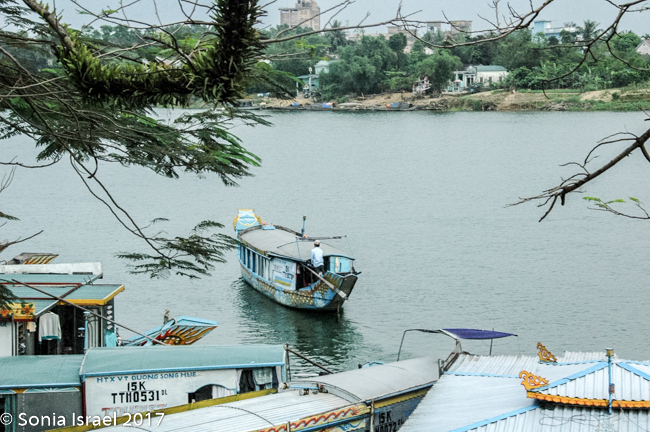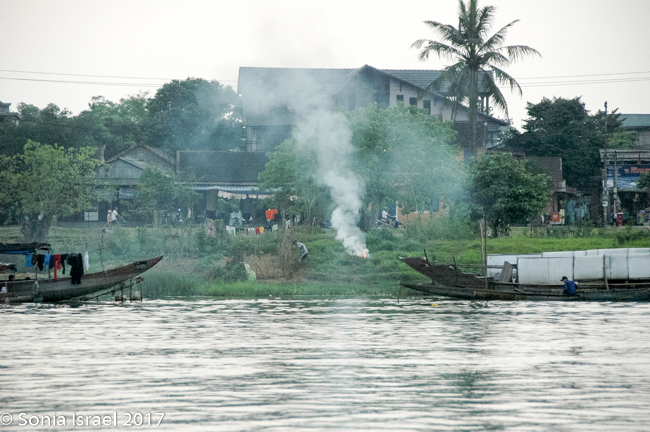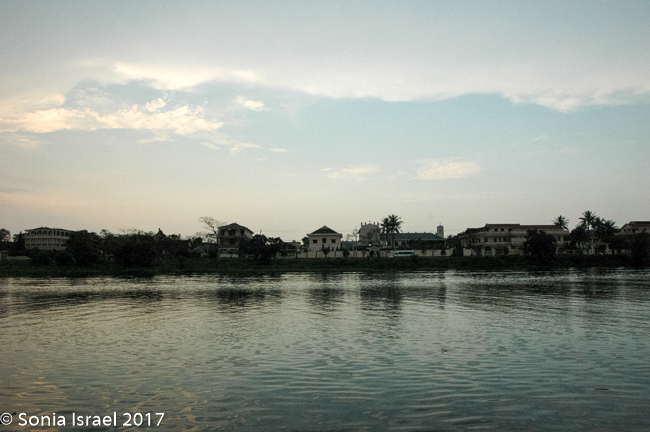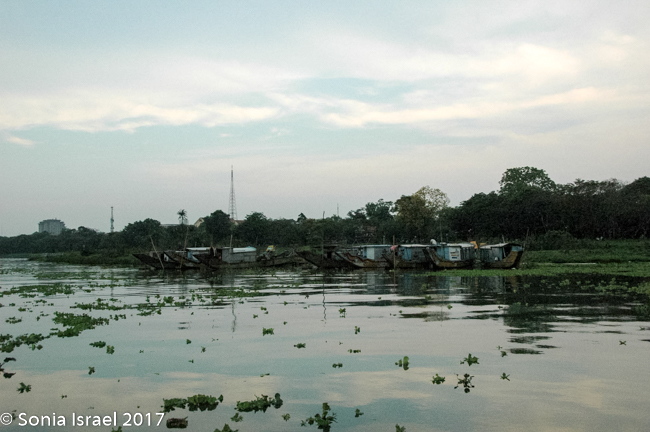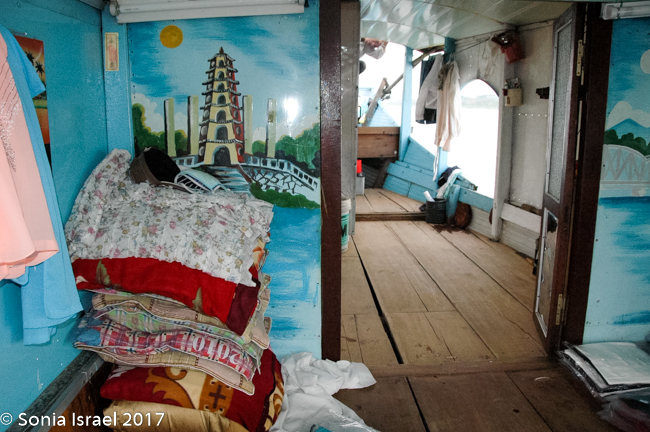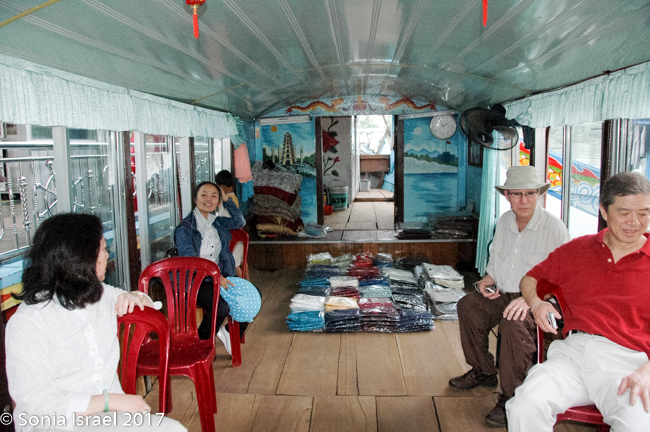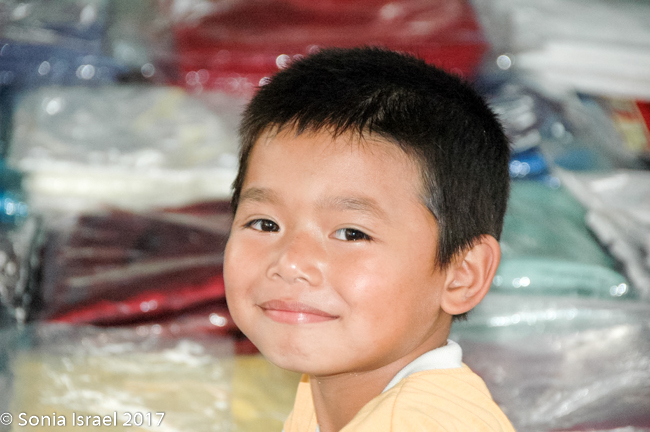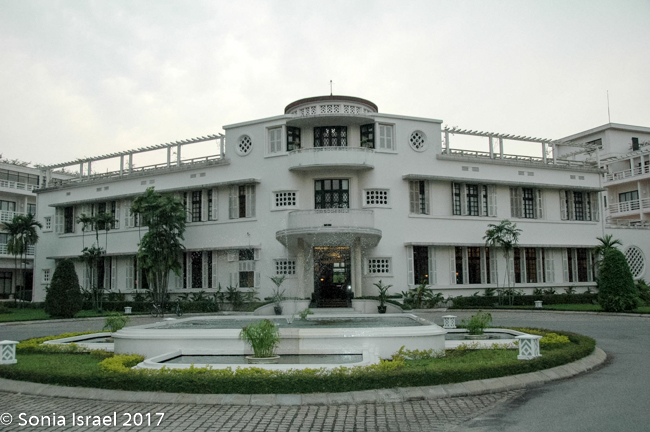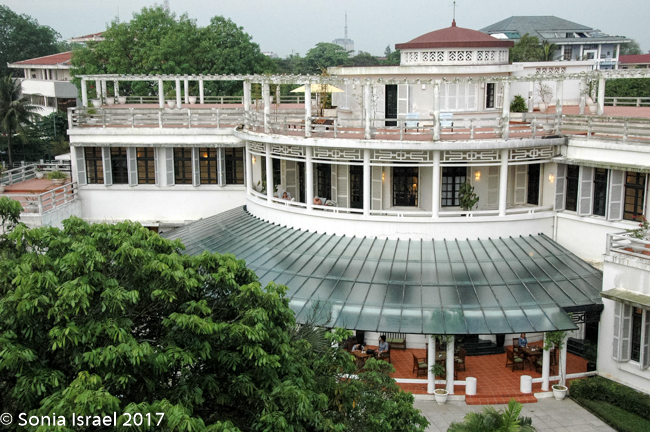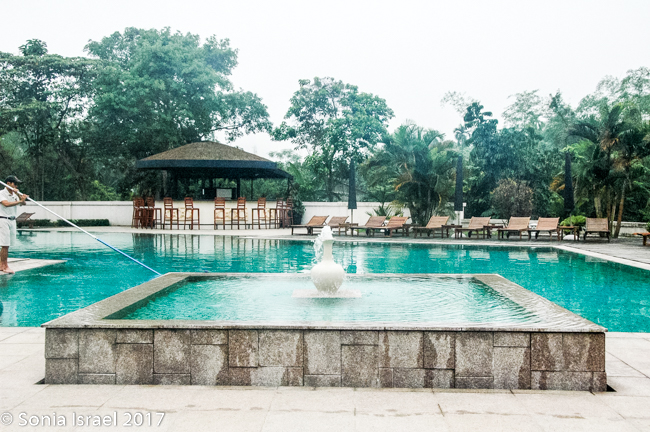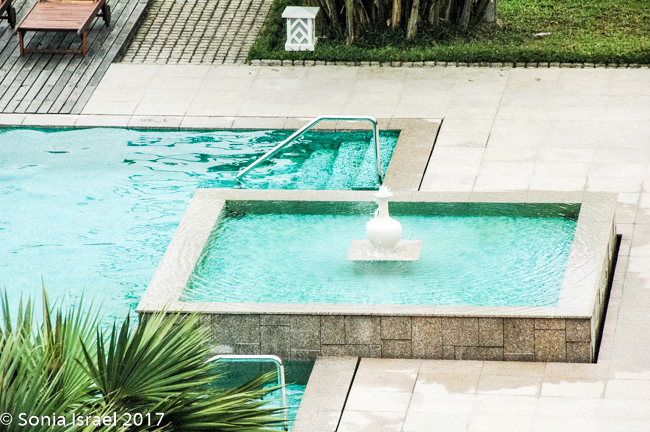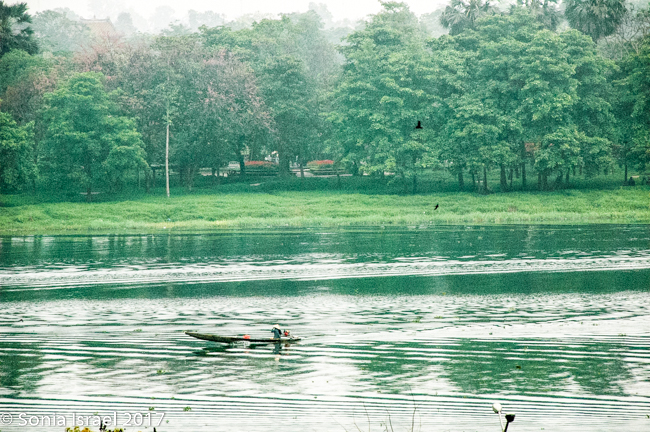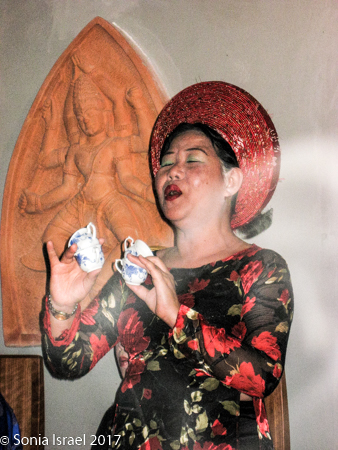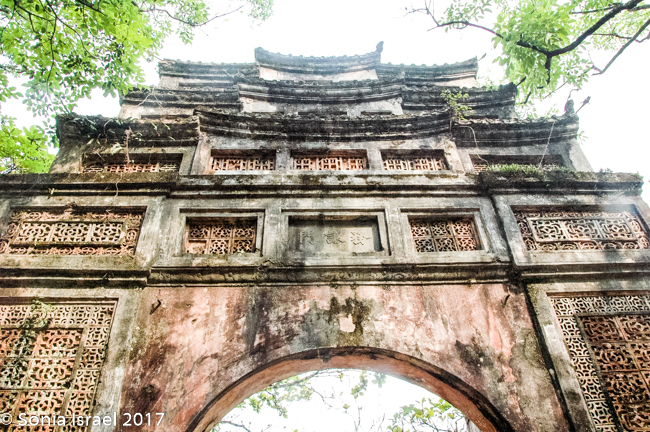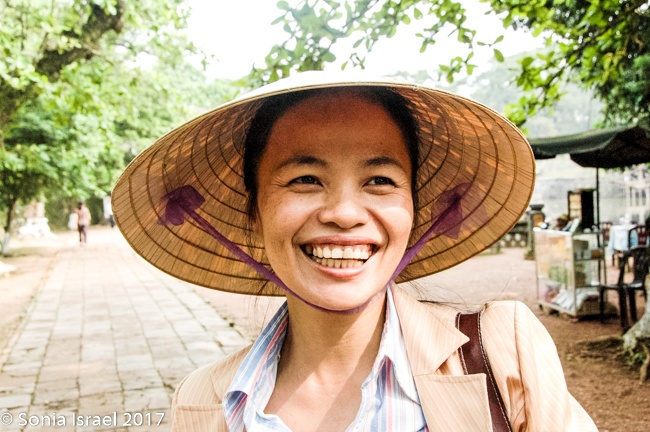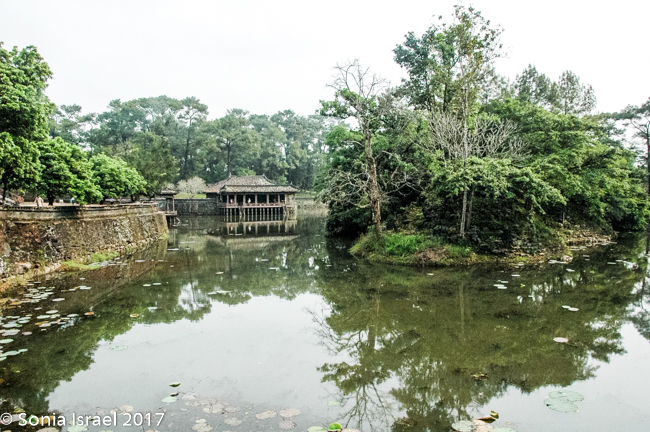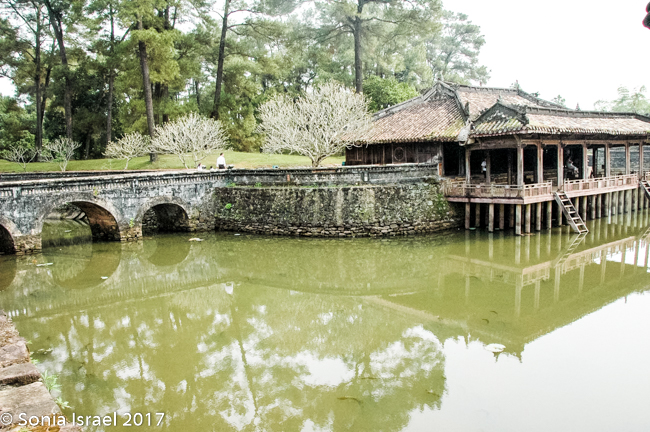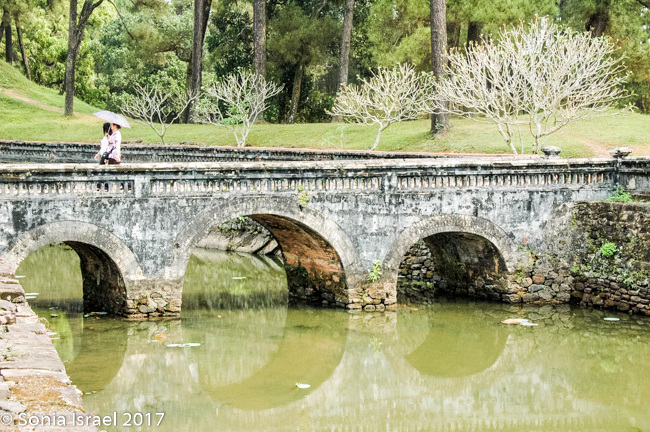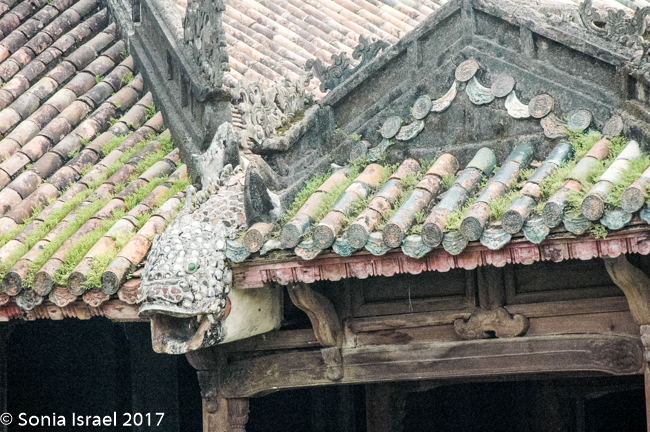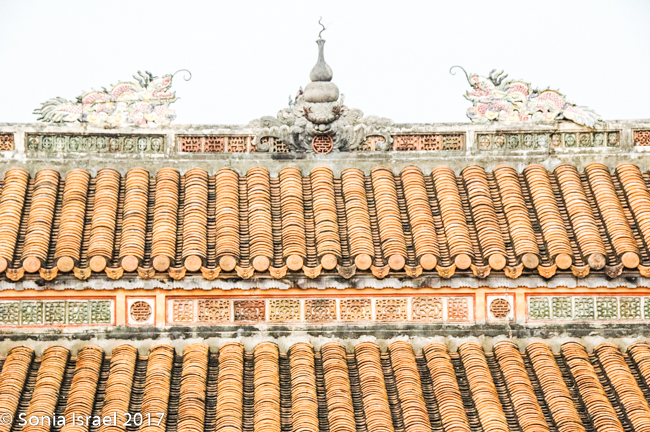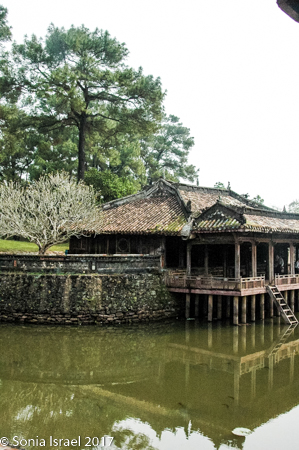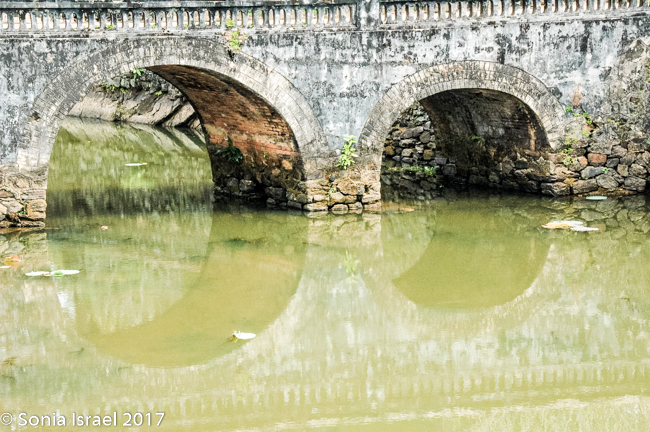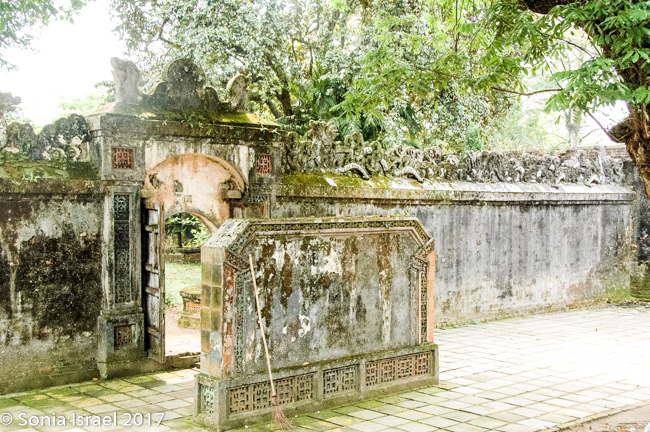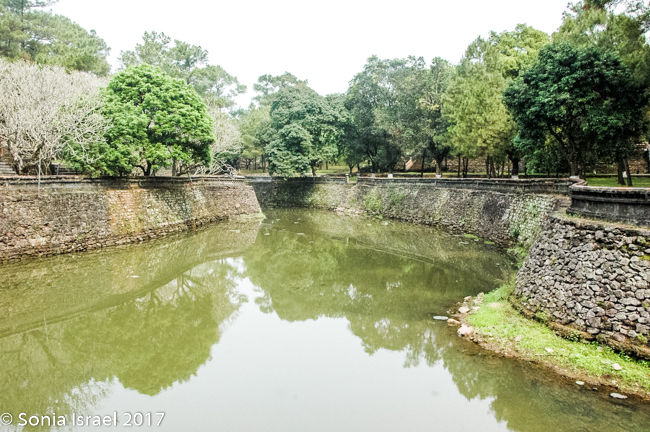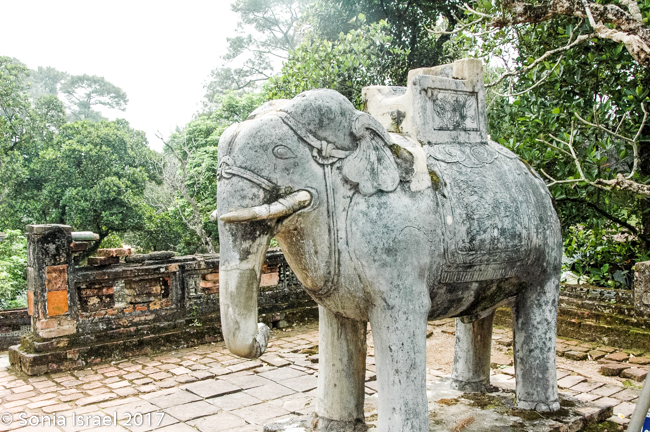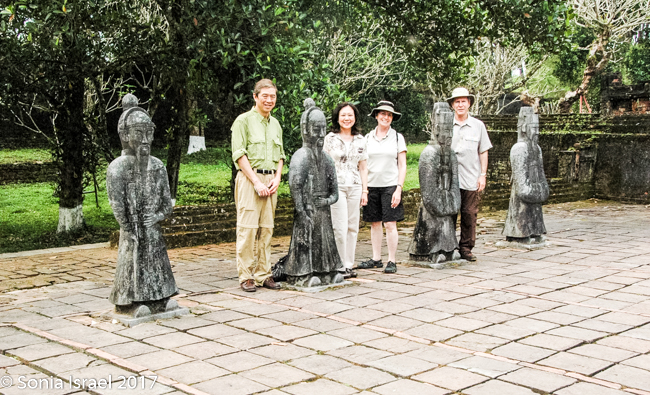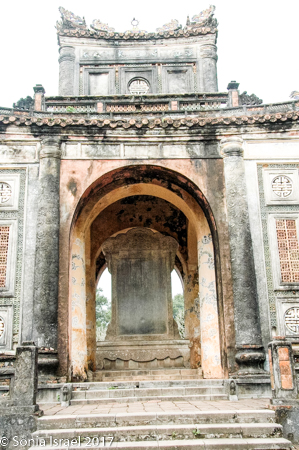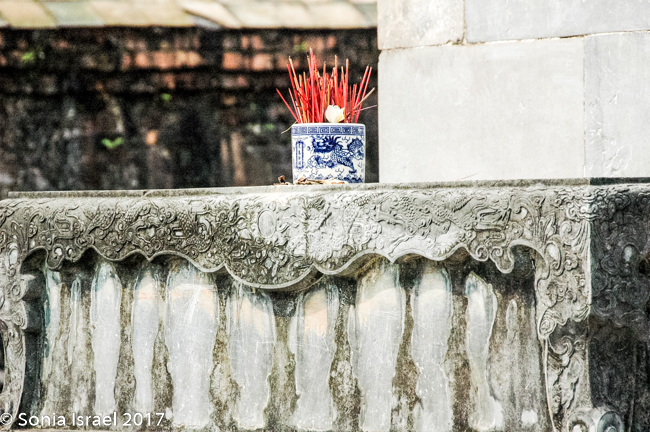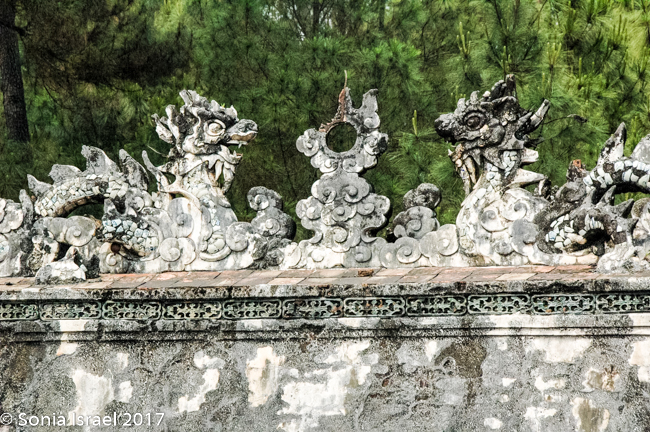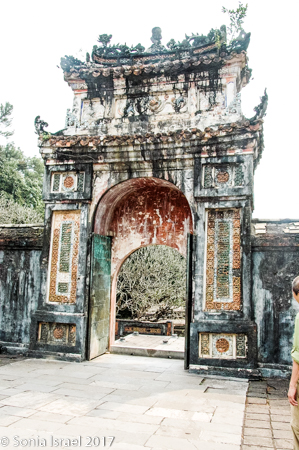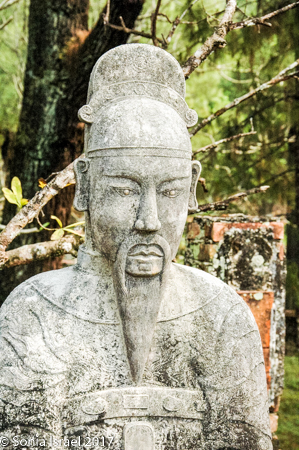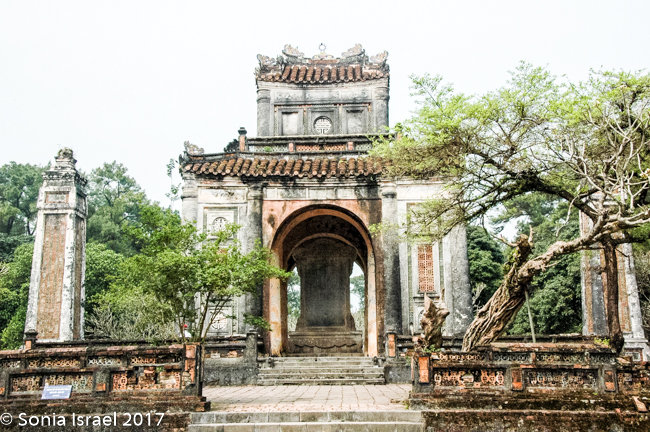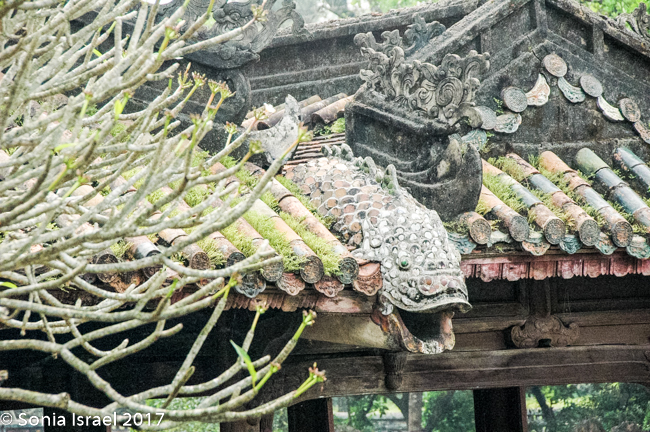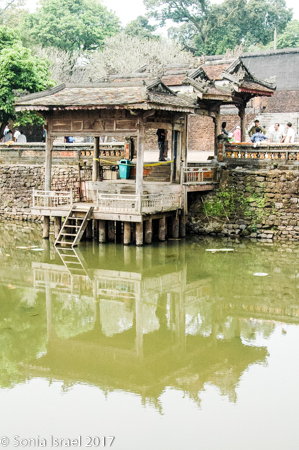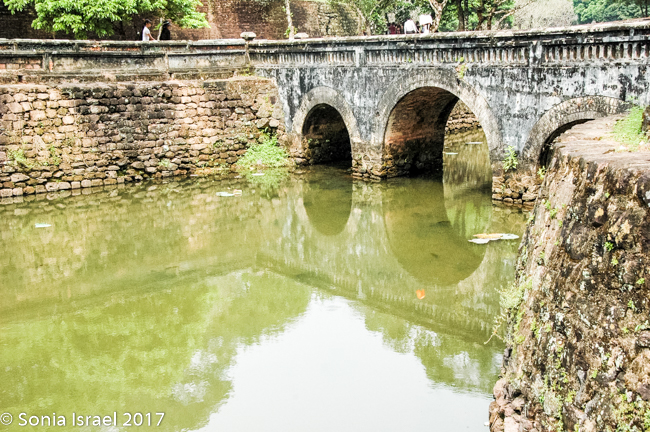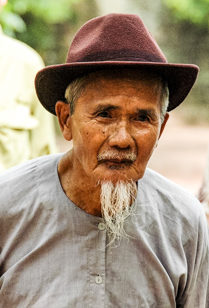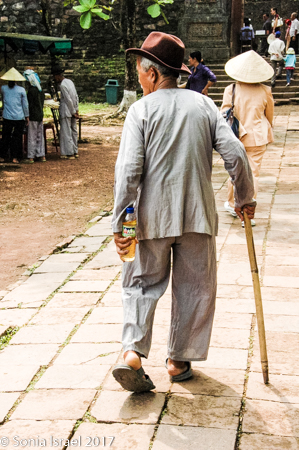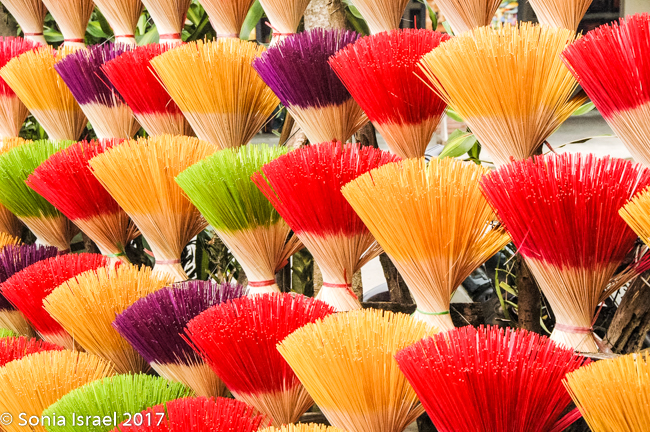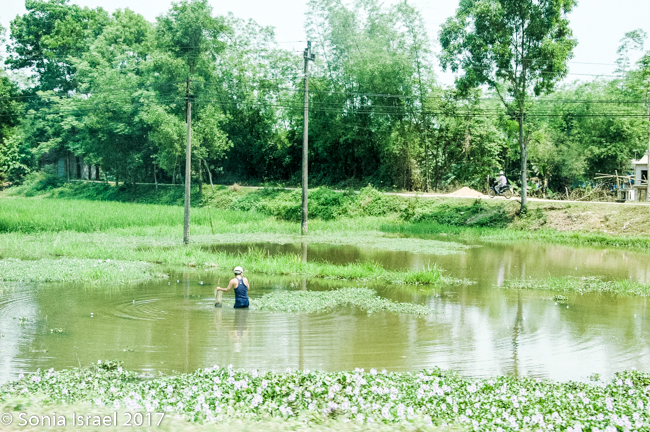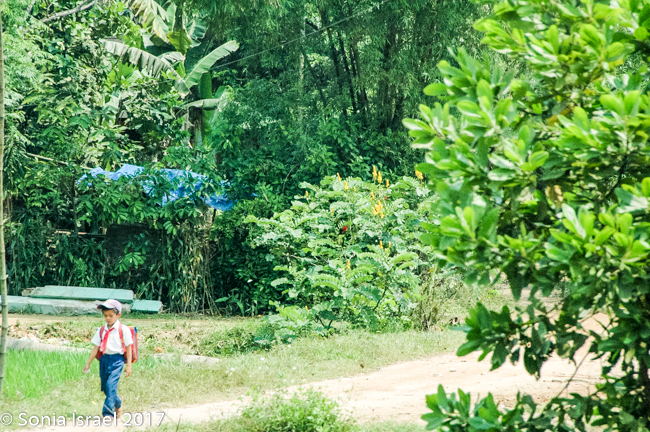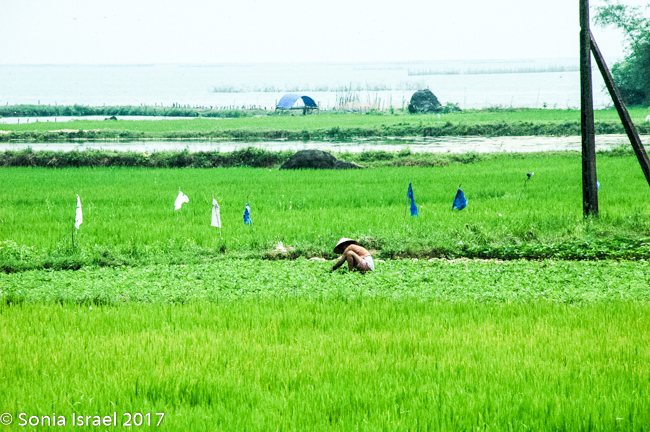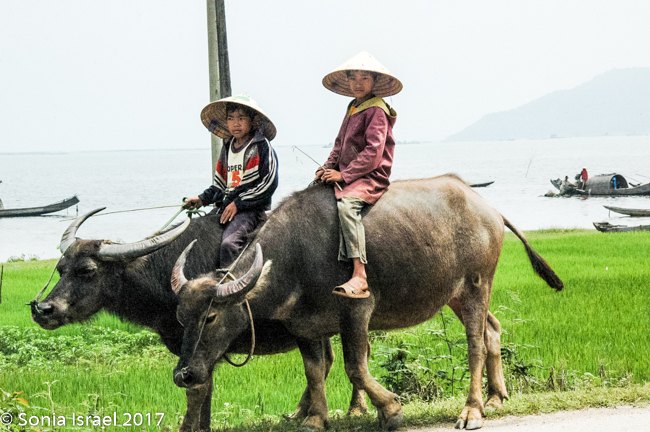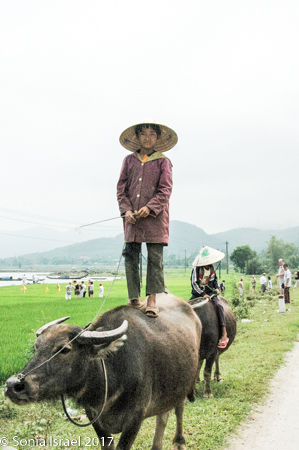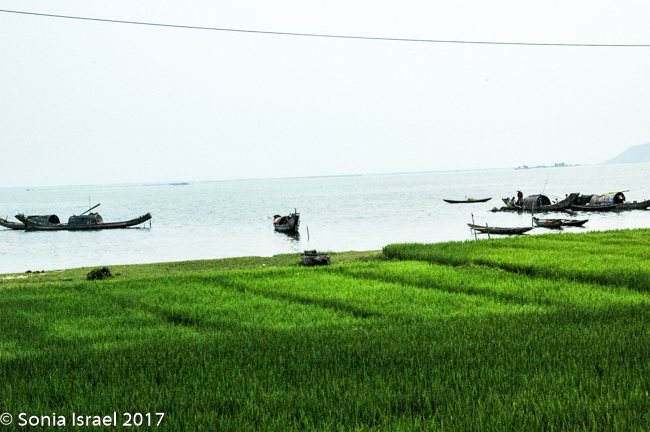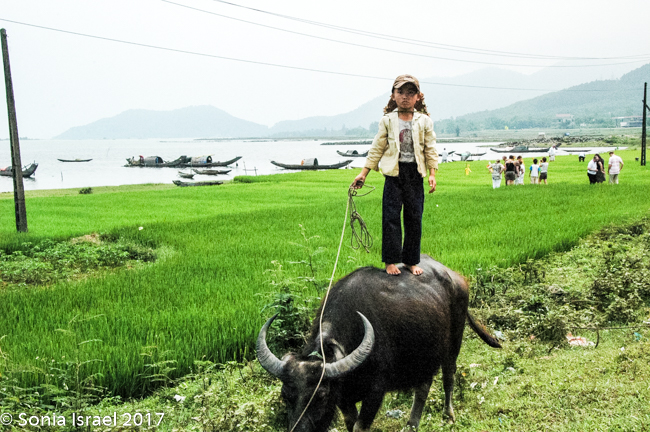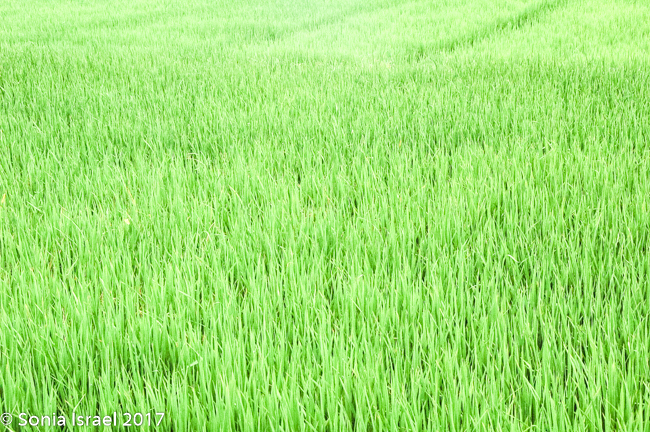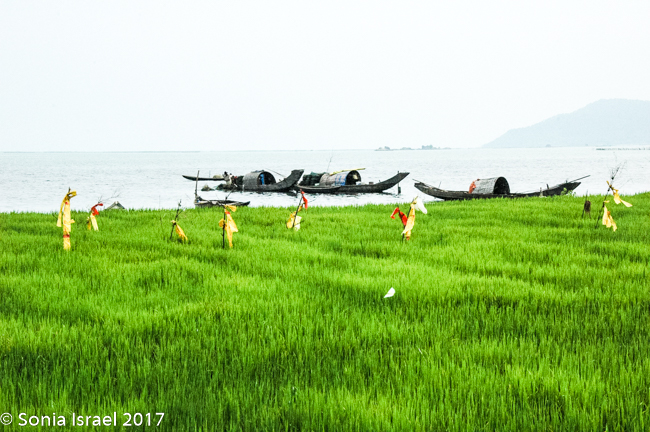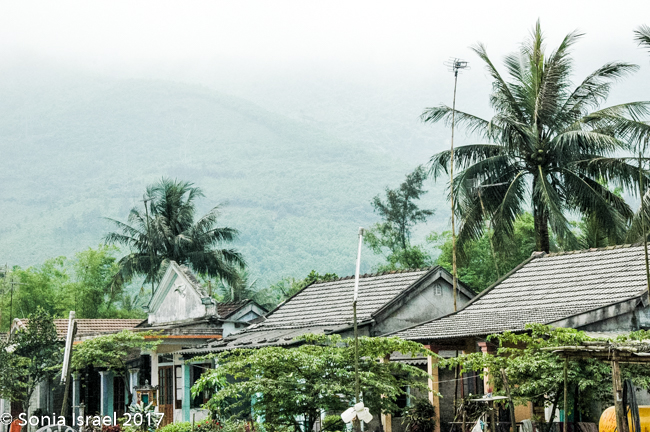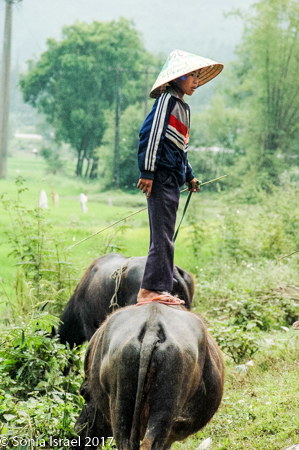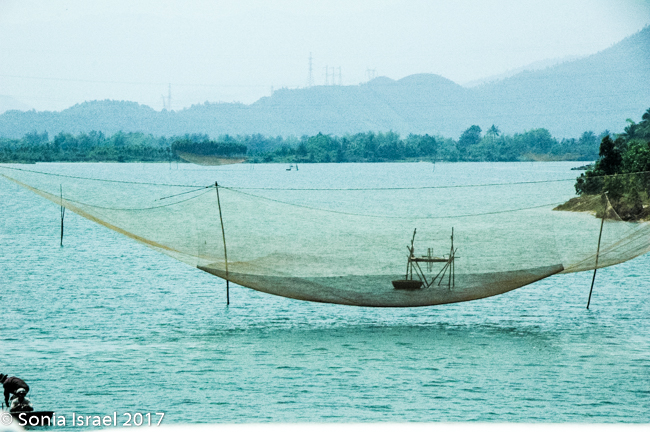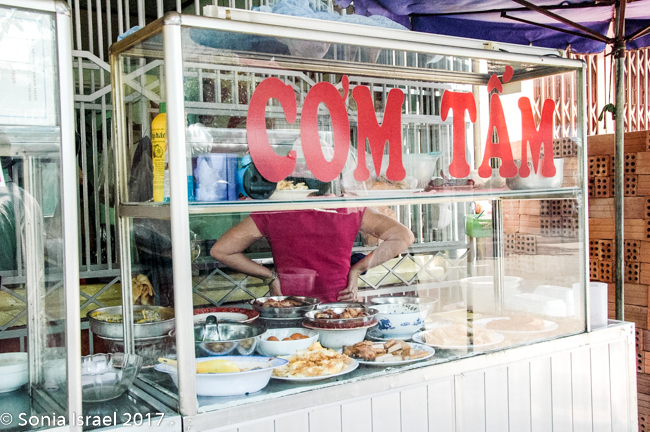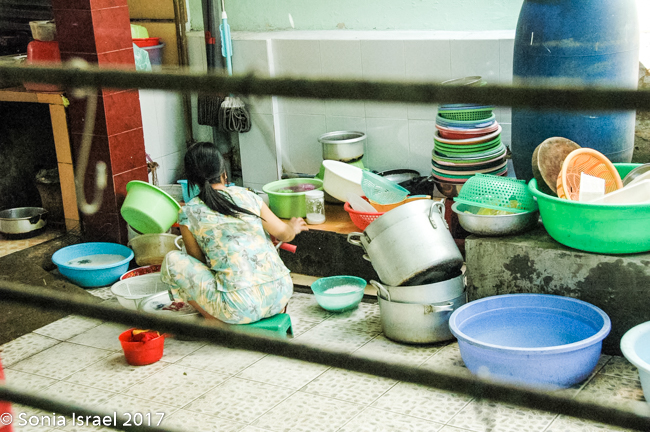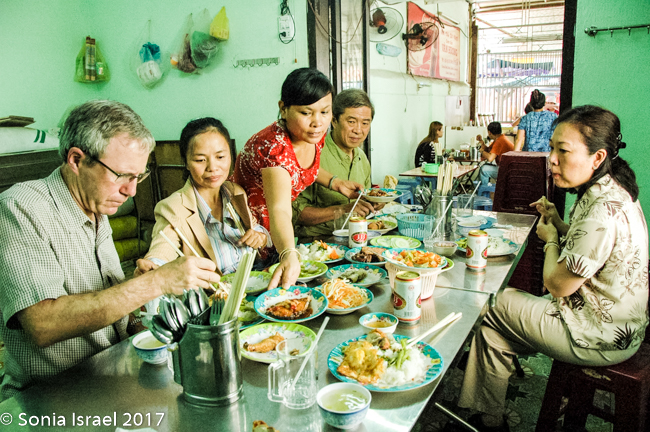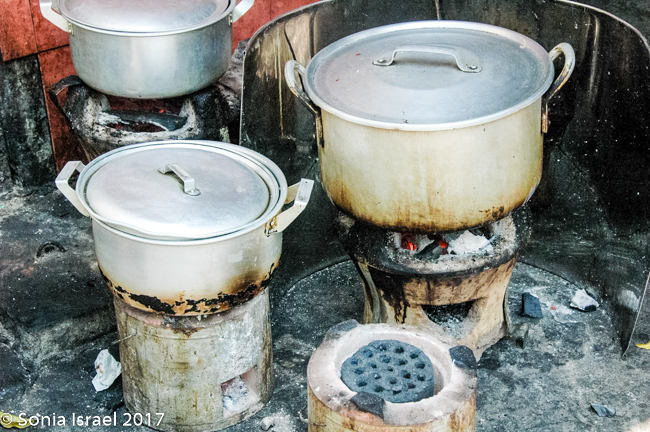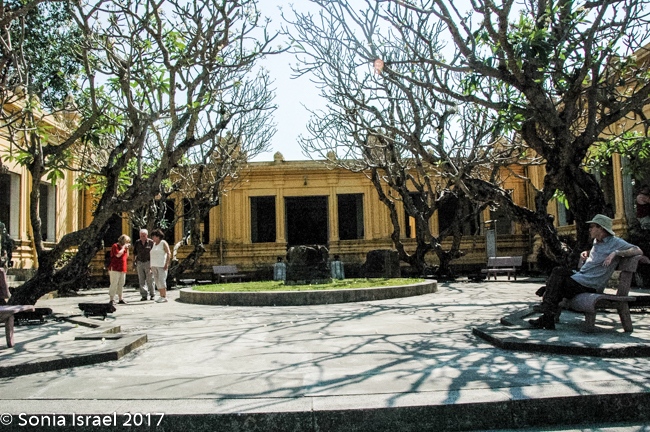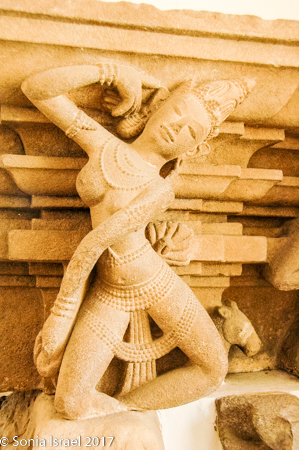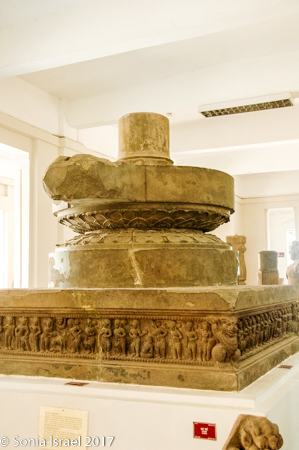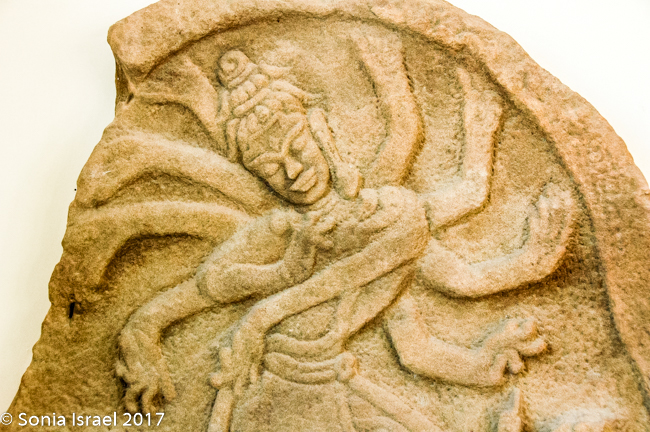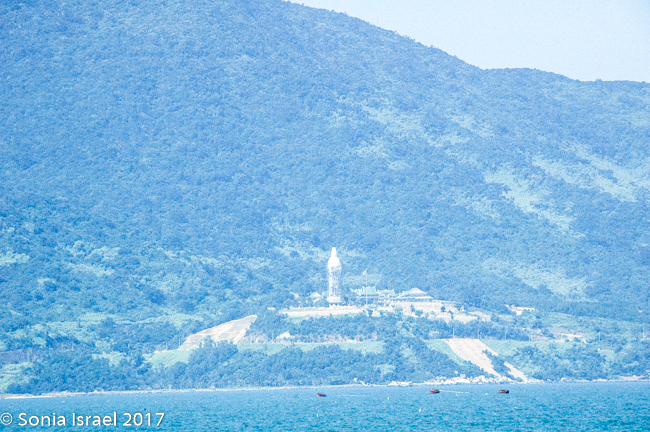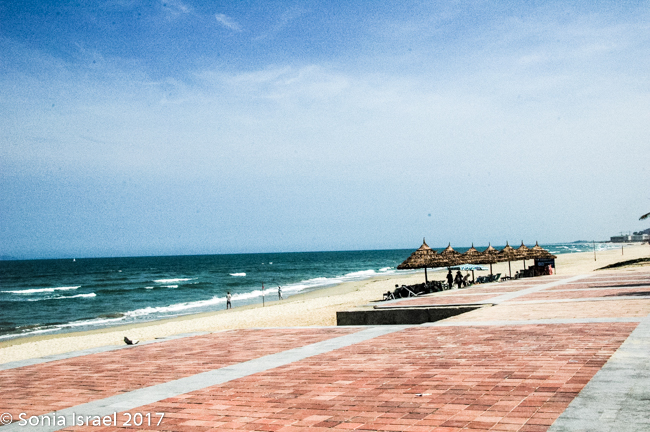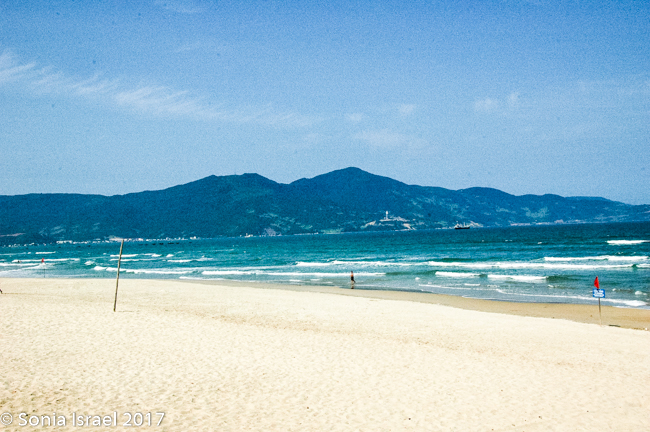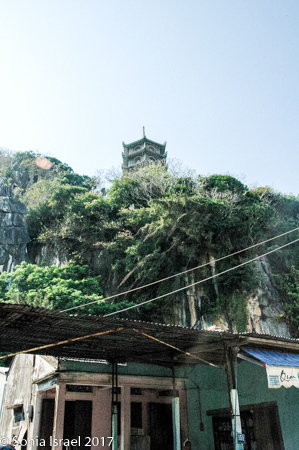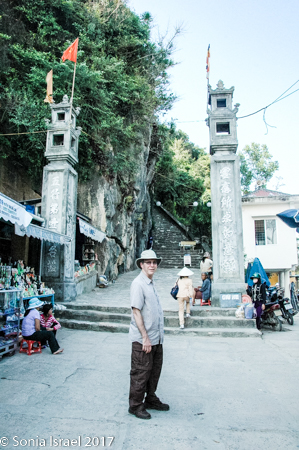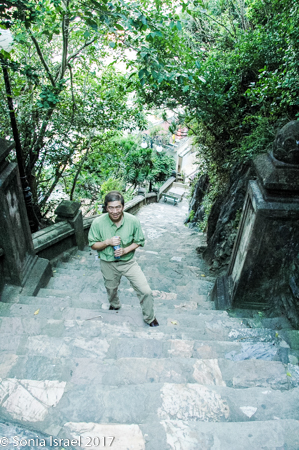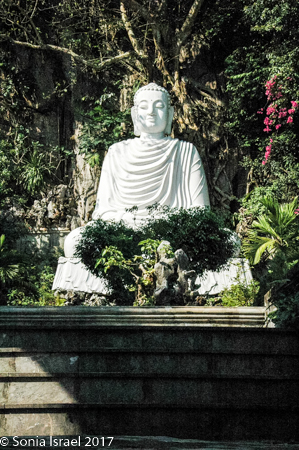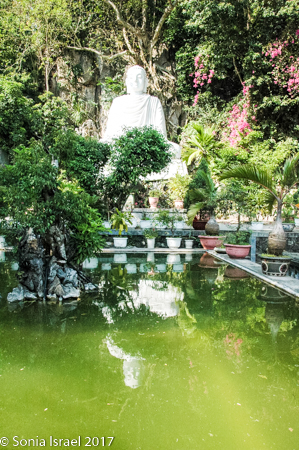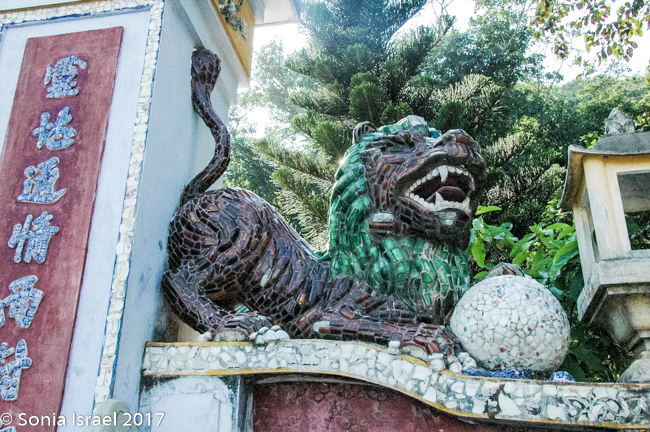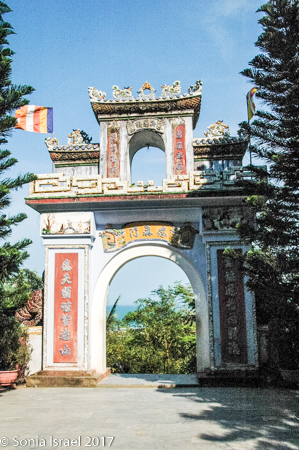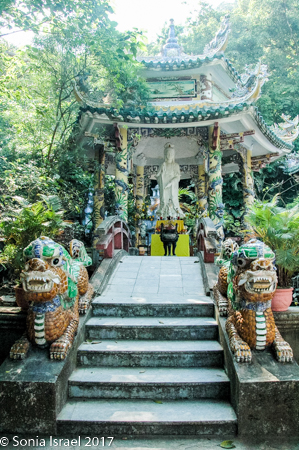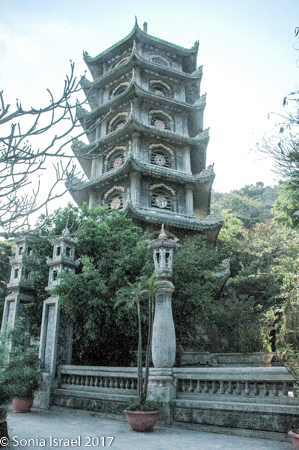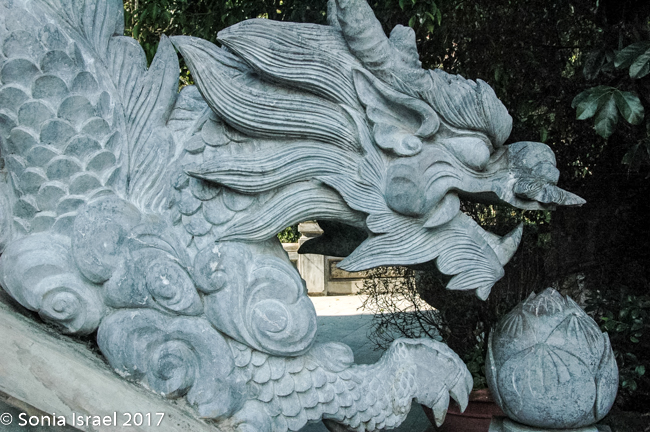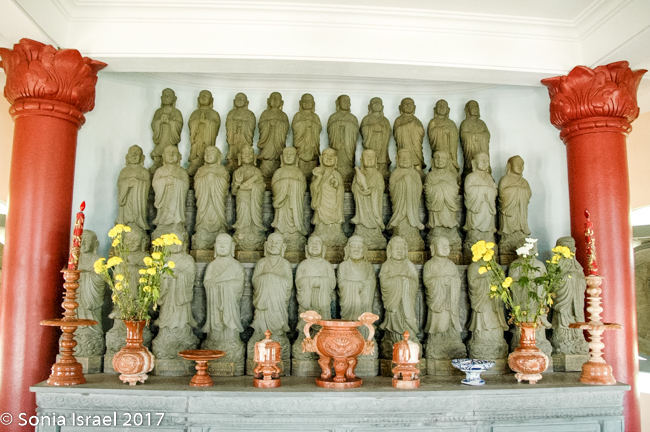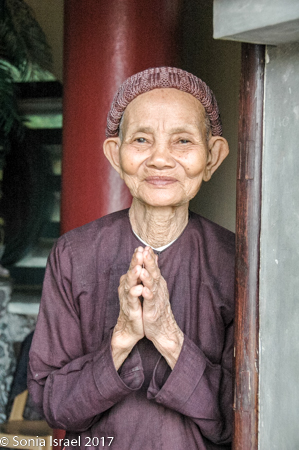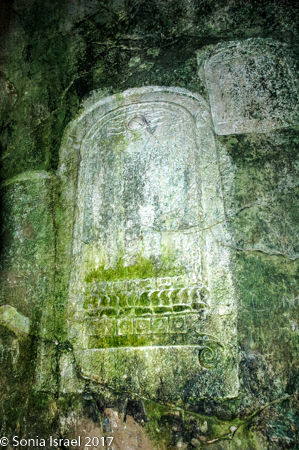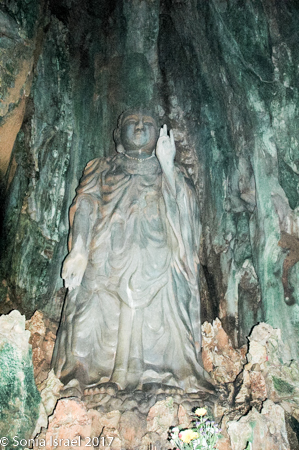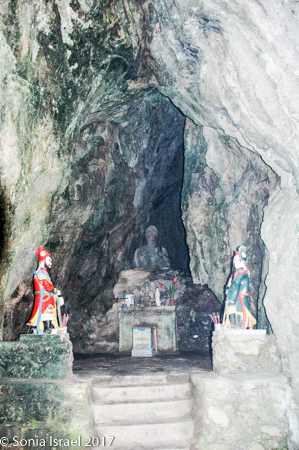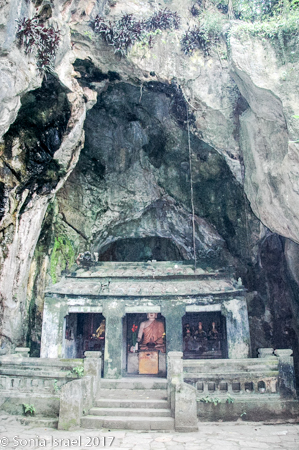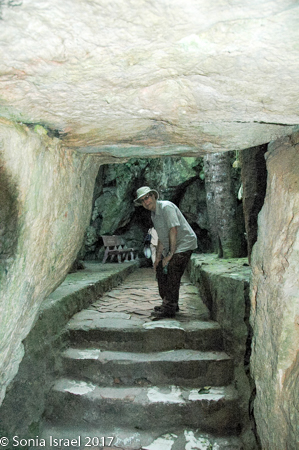Saigon to Hue
Wednesday March 18, 2009
Today was a lazy morning as we were not being picked up from our hotel in Saigon until 11 (see the Saigon entry). We had our last wonderful breakfast on the roof overlooking the river, packed and then Phyllis and I headed out to do a bit of shopping. And what do you know – I found a dress, perhaps to wear to my daughter’s upcoming wedding! Down the block from the hotel was a shop of a young, famous Vietnamese designer, Minh Khoa. Here is what Travel and Leisure says about him: “Members of the city’s beau monde favor couturier · Minh Khoa who has made a career out of reimagining iconic garments.” His dresses were all beautiful – I could have bought any number of them. And the prices were ridiculously cheap by our standards. One in particular caught my eye. They offered to make one for me in two days. I told them we had one hour. So, they motorbiked it to the factory and fixed it to fit me. Even made me a matching shawl. So at 11 we were ready go, dress in hand.
Hue
The flight to Hue was only an hour and once again we were met by our guide, Oanh (pronounced One). Hue was the capital of Vietnam, the feudal sovereignty, from 1744 when the Nguyen lords controlled all of southern Vietnam from the city. The dynasty of the Nguyen family lasted from 1802, when Nguyen Anh defeated rebels to control the city, until 1945, when the last emperor abdicated. The city was severely damaged in the 1968 Tet offensive when house-to-house fighting lasted for weeks. Almost everything was destroyed and is now being rebuilt.
Citadel and Imperial Palace
Hue is divided between the old and new parts. We drove directly to the older part to visit the fortified Citadel and Imperial Palace. The outside wall is the original but everything else has been reconstructed and was declared a UNESCO World Heritage Site. One or two buildings are complete and the rest is still under construction. It resembles the Forbidden City of China, but not as elaborate or as beautiful. Inside the citadel was a forbidden city where only the concubines, emperors, and those close enough to them were granted access, the punishment for trespassing being death.
- Emporer’s Robe
- Emporer’s Robe
- Original Gate
It was then off to see the Thien Mu Pagoda, seven stories high and the tallest in Vietnam. It was the home of the Buddhist monk Thich Quang Duc who burnt himself to death in protest of the Ngo Dinh Diem regime. The car that took him to the site of the death in Ho Chi Minh City in 1963 is there (Andy of course loved the old car).
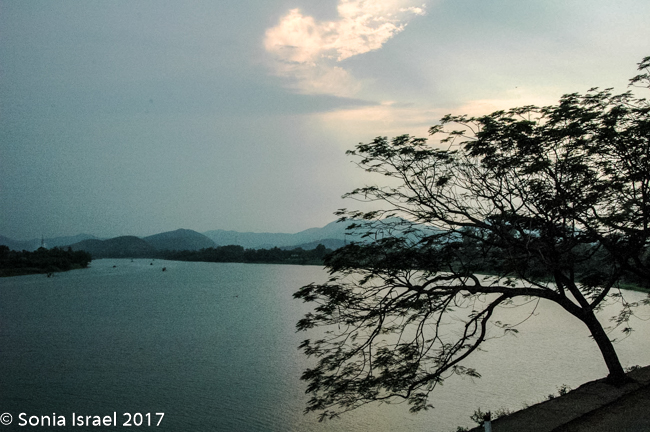 The pagoda sits on the Perfume River, called that because it was once used to float flowers, thus giving it the smell of perfume. No longer…..
The pagoda sits on the Perfume River, called that because it was once used to float flowers, thus giving it the smell of perfume. No longer…..
We took a boat ride on the river in a boat that also doubles as the home of the boat keeper and her family. We sat in the front, their living space and kitchen in the back. Now I realize I just made it sound like a large boat. Not so. This was a small vessel with essentially one room. They had pillows stacked on the side which clearly were their beds. And the floor was covered with items for sale, such as silk shirts, pants, robes, scarves. Sailing tourists down the river I guess only goes so far while selling souvenirs helps buy food. The locals who live beside the river are very poor and wash their clothes and bathe in the water. Also, they earn money by dredging the river bed for sand which is then sold to cement manufacturers for a tiny price.
Only after all the touring did we get to check into our hotel, Le Residence. It is in the French style, sprawling with an elegance that seems out of place in a town like Hue (not really such a small town – population of 400,000).
- The Perfume River from the hotel
We had dinner later that night in the newer part of Hue which is less interesting and contains most of the facilities, the hotels, restaurants, travel agencies, and banks. We ate at the Tropical Garden which had local Vietnamese food and local singers in local costumes signing folk songs. We then had a nice long walk back to the hotel and collapsed. The days are long and tiring, but also fun and interesting.
The Road from Hue to Danang
Thursday, March 20
Hai Van Pass
What a full day today was. We woke early, as has been our habit and just relaxed for a bit before being picked up. Breakfast was the usual beautiful buffet with both Western and Asian choices. Then it was on the road again, this time heading south to Danang through the 4900 ft high Hai Van Pass, Vietnam’s geographical and psychological boundary between north and south. This also struck me as an important place as my memories of the north and south were not positive ones. But the pass was gorgeous. The peak of the pass lies perpetually shrouded in clouds, as it was today.
The Tomb of the Fourth King of the Nguyen Dynasty – Tu Duc
Oanh decided we would not stop at the tomb on our original schedule, but rather to one she thought was more beautiful – the Tomb of the Fourth King of the Nguyen Dynasty – Tu Duc, who ruled from 1848-1883, starting at age 16. The people did not like him at first as he built rich palaces for himself while they were poor. But in the end he won them over. He had over 100 concubines, but no children. This tomb is one of the few that still has original parts and the rest has already been restored. The grounds were beautiful, and very reminiscent of China, but not as elaborate or spectacular. There were beautiful reflections of the houses in the moat which made for beautiful pictures (of course). There were structures where the king would go to compose poems, where the queen and concubines lived, and of course the tomb. A dry lake was dug in front of the tomb representing the sorrow of having no children. Usually, the oldest son would write about his father’s life upon the father’s death, but since Du Tuc had no children, he himself carved in stone, the narrative of his life, his imperial rule, his adventures and his misadventures. Tu Duc’s tomb is considered one of the most beautiful works of the Nguyen dynasty, and a romantic place with mountains and lakes.
- Oanh
If you have been following my entries, you know that one of the things I like most about traveling is the people. And I love faces, especially the faces of older people. There was an older gentlemen at the tomb with the most wonderful face.
Some things we learned on the drive
We then had a long ride to Danang, and on the way learned many, many things. For example, when people die, they are first buried by the river for 3 years. Once there is nothing but bones left, they are moved into tombs in the hills/mountains as the mountain represents the ruler. That shows respect to the ancestors. In the Saigon area, there were no mountains, so people are buried in tombs either in the rice fields or next to their children’s homes.
We talked a lot about life under communism. Both our guides said that life is better now, BUT, life is also very hard as people are very poor. Oanh’s husband works in the post office in Danang and makes about $100/month. In Saigon, the average wage is under $200 a month. So people are poor. Even though they live under communism, they do not get many services; rather have to pay for everything, including medical care (unless you want to wait forever to be cared for), education (beyond 5gth grade) etc. There is also corruption everywhere. Police will often stop locals just for a bribe. At the entrance to the museums or on the toll roads, there are two booths – pay for your ticket at the first and prove you have a ticket at the second.
The number of children is restricted to two. Policemen and other government officials are fired from their jobs if they have more than two children. Why you ask? Because the government only wants to cover education for two children. Beyond that you are on your own. School in the villages is often only until fifth grade. Oanh says if you teach them to read and write but not to think, it is easier for the government to control them. Interesting, hmmmm. Children go to school 6 days a week, but only for 4 hours a day. And they go in shifts. Work in the fields or fish in the morning and go to school in the afternoon, or visa versa.
Once parents have their two children, they move into separate bedrooms and are no longer intimate. Oanh says they never even kiss again. Hard to believe if this is true. But since about 50% of marriages are still arranged, perhaps it is true.
Road to Danang
The trip to Danang was very beautiful. The countryside is much more interesting than Saigon was. The sky was full of yellow butterflies – literally full! I have no idea why. Little children in their white shirts and red ties were walking or biking home from school. The rice fields were different shades of green (dark green when just growing, white as the rice flowers, yellow when ready to be picked). Men and women in their conical hats would be out in the rice field working. And every so often there would be a water buffalo out in the field as well. Oanh found a place for us to stop to photograph children sitting on water buffalo. Ok, Ok, so we had to give them a buck. It is one of the ways they make a bit more money. So we were happy to oblige.
Danang
When we got to Danang, Oanh needed to stop at her home to drop off her milk (she is nursing her 7-month old baby). So we got to see a real Vietnamese home. She paid $25,000 for a narrow, three storey home (very, very cheap in Danang she says). It had teak furniture, a fountain and an altar in the living area. There was also a kitchen. The second level is the bedrooms. Her mother-in-law (“not easy to live with mother-in-law,” she says, “because mother in law thinks son is always right.”) lives with them and takes care of the baby as Oanh works seven days a week.
We told her we want to have lunch in a local place and she was the first guide we ever had that listened. She took us to a small place where she takes her family to eat, a place called Van Huong . We were the only non-Vietnamese there. She ordered for us – food cooked outside on the street – and we had the best meal yet. The rice was short grained and a bit sweet. The chicken was sublime. The green beans the best ever. Fresh fish. And of course we had BaBaBa (which means 3 3 3) – the local beer. Phyllis and Ben also had pork chops and squid. And the price for the whole meal for five of us? 268,000 dung or the equivalent of about $18 (or $3.60 each).
We were beginning to get tired out, but the day was not over yet. No, next it was off to the Champa museum which has the largest collection of Cham sculptures from the 12th-15th centuries. The Cham were very influenced by India and China, and today they no longer exist.
We visited the famous China Beach, which basically is just a beautiful beach near the old (they call it relic) US military base. The entire beachfront is being built up into mega resorts and convention centers. Look out – your next meeting just might be in Danang.
Marble Mountain
And the day still was not over. It was time to head towards Marble Mountain (not to  be confused with Elephant Mountain and Monkey Mountain which we also passed through and which were all shrouded in fog). Marble Mountain is surrounded by villages carving marble. The air is full of dust and the trees all look white as they are all covered with that fine while film.
be confused with Elephant Mountain and Monkey Mountain which we also passed through and which were all shrouded in fog). Marble Mountain is surrounded by villages carving marble. The air is full of dust and the trees all look white as they are all covered with that fine while film.
Ling Ung Pagoda and the Dang Chon Grotto
We stopped next at the Ling Ung Pagoda on the Son Thuy mountain facing the sea. It was rebuilt in 1970 with contributions from followers of Buddhism. The Dang Chon Grotto (Truth-Storing Grotto) lies behind Linh Ung Pagoda. Day light reaches down to the grotto chamber through openings at the top. The climb up to the pagoda was 150 steps up, and while the pagoda was nice, the cave was a natural cave where the stalagmites and stalactites were carved into the largest buddha. Quite impressive.
